The upholstery trade as a craft evolved throughout many centuries and various eras as it gradually integrated into the furniture making process. While stages of comfort levels increased, tradesmen provided materials for the covering of chairs, seats and sofas.
The coordination of padding, springs, webbing, fabric and/or leather materials covering a wood frame or platform is the essence of this artistic skill. Fabrication of seating furniture requires design aesthetic with the essential components of comfort and function.
Unlike residential seating, hospitality/commercial standards require materials with greater durability to withstand the environmental stresses of continuous daily use. This includes heavy-duty hardware, thicker wood frames, greater density of foam and more resilient fabrics.
The following are the underlying components holding to industry standards for hospitality and contract seating.
Download Our Quality Upholstery Whitepaper
Frame:
Upholstery frames should be constructed with thick, kiln-dried hardwood. The joinery of the frame is critical to durability and appearance; quality construction includes double doweled or mortise and tenon joinery, glued, with corner blocks screwed to the frames for solid longevity. Fitted corner blocking is an essential component in enhancing stability and prevention of loose joints.
Webbing:
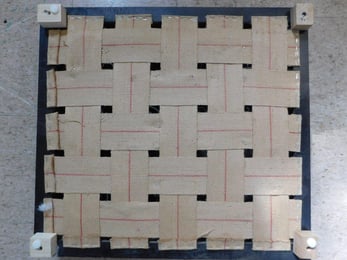
Jute webbing is created of a fibrous, burlap-like material whose main function in upholstery is to provide a foundation for the seat and/or back. Strips of jute are attached to the frame in a basket weave fashion in support of coil springs. Because there is no elasticity in the jute, this type of webbing offers structural integrity to coil spring construction.
Jute Webbing
Other types of webbing include Pirelli or rubber/cord types. These webbing systems provide flexibility due to elasticity (rubber) with reinforcement and resilience (cord) and offer excellent alternative for support in models that can not accommodate eight way hand tied. In addition, this strong functional suspension is commonly used in lieu of sinuous spring for seating with low profile or tight or slip seat design.
Suspension:
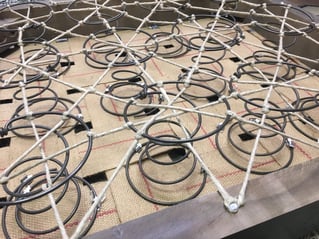
Eight-way hand tied coil spring suspension is the most labor intensive and represents the mark of highest quality. Numerous coil springs are supported from underneath with jute webbing and secured to one another with string, tied by hand, touching each spring at eight different points. The string eliminates shifting of the springs for even suspension and most comfort.
8 Way Hand Tie
Sinuous spring suspension is an alternate system of two dimensional, zigzagging pieces of metal secured in rows, cross tied to each other, then to the wooden frame from front to back for strength and resilience. This method provides consistent quality throughout the seat surface, and is often used in back areas of upholstery.
This is a common solution when there is not ample room for coil spring construction. Sinuous suspension is less labor intensive, therefore less costly.

Sinuous Spring Suspension
Not recommended for high quality hospitality use are drop-in coil springs. This system is mounted on a frame and added as a single unit. Drop in units are unsupported from the bottom and do not offer the same durability.
Cushions:
Seat and back cushions can be constructed in a variety of ways. Industry standard in the hospitality market calls for more demanding criteria due to durability required in areas of perpetual, heavy use. Foam, padding and springs interact for a comfortable, resilient “ride.”
Foam:
Density of foam refers to weight. The more foam weighs, the higher the density. Greater density yields more resilience and durability, thus higher quality. Heavier foam yields less breakdown and greater longevity.
Firmness of foam allows for different comfort levels. Indentation Load Deflection (ILD), a numerical system from 10-90, gauges the amount of pressure required to compress the foam. Lower numbers equals softer; higher numbers equals more firmness.
Support is based upon thickness of the foam, which should support the weight applied to it. The balance between support and comfort is imperative in a quality cushion.
Fox Edge or edge roll is material attached to the edge of the wooden frame to soften the sharpness. It eliminates the obtrusive feeling of the frame while seated, at the same time protecting and preventing fabric from wearing at the sharp edge of the frame.
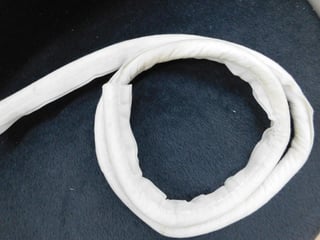
Finishing Touches:
Varied design styles in seating present a different look as well as a very different sitting experience. For example:
Tight Seat and/or Back: upholstered seat or back designed without loose cushion; foam and fabric are both upholstered directly to the frame.
Loose Seat and/or Back: upholstered seat or back designed with loose cushion
Semi-attached Seat and/or Back: upholstered seat or back designed with cushion sewn or zippered (sometimes Velcro) into place. Not removable for turning or filling replacement. Commonly found on ottomans and benches to prevent the cushion from slipping or sliding.

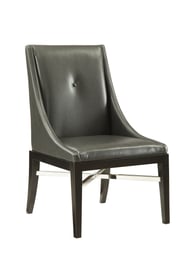
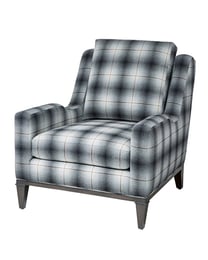
Tight Seat Loose Seat Semi Attached Seat
Welting:
Welt is a fabric-covered cord that follows the seam of a chair cushion, sofa cushion, or pillows for a tailored look. It is used to provide a finished, elegant look, as well as cover exposed and raw edges between fabric and wood frame.
Welt cut on the bias at 45-degree angle allows easier manipulation of the cord and curves. It is also a noted attribute to the finished appearance of upholstery that adds a dignified design element. Because it is more labor intensive, many hospitality manufacturers do not apply this high-end feature to their product. This process also avoids the issue of directional pattern that would otherwise require matching of welt with seat, back, arms, etc. in order to correctly line up. Welt not cut on the bias may cause welting to pucker and distort as it is applied.
Self-welt uses the same fabric covering the upholstered piece.http://samuelsonfurniture.com/product/8493/http://samuelsonfurniture.com/product/8507/http://samuelsonfurniture.com/product/bench-19/
Single Welt is one single, fabric-covered cord finishing cushions or area where fabric meets frame
Double Welt consists of two attached, fabric-covered cords sewn together for greater coverage where fabric meets frame
Contrasting welt uses another fabric to highlight detail and create interest.
Tufting:
Tufting adds a decorative, distinguished element to furniture and cushions. Stitches or buttons are sewn through the item and pulled to create dimension and pattern. On the functional side, tufting may prevent the stuffing inside the item from bunching or shifting.
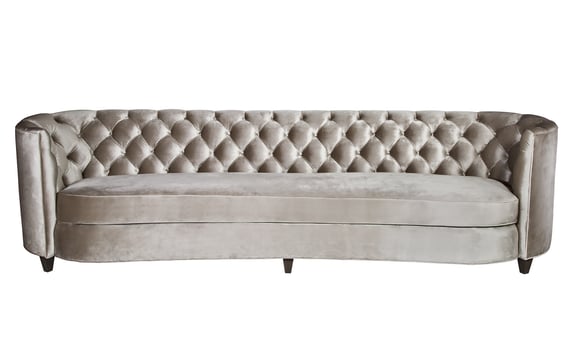
Diamond Tufting
Button tufting is accomplished by using button forms, which are metal button blanks that are covered with same or contrasting fabric to the object being tufted. They are pulled through the fabric with meticulous folds or pleats to create diamond, square or rectangular shapes.
Blind/Stitch tufting can be accomplished without buttons by using thread or twine to create the tuft.
In Conclusion:
A basic understanding of what underlies the manufacturing of quality, long lasting upholstered product for hospitality environments will lead to better choices when selecting product for your projects. Look for the balance of aesthetics and durability when choosing the right vendor.
Download Our Quality Upholstery Whitepaper
Visit us at BDNY - November 12-13 - Booth #1303 - Open Bar Noon-5


